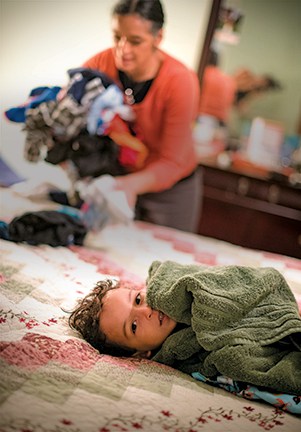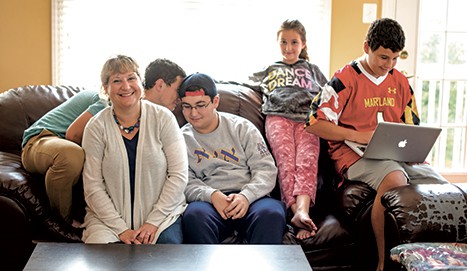STORY BY Halima Aziza PHOTOGRAPHY BY Mary C. Gardella
NOVEMBER/DECEMBER 2015
Oh, you’re expecting! Do you hope it’s a boy?”
“You have all girls … Are you disappointed you didn’t have a boy?”
“You’ll have to excuse him. After all, boys will be boys!”
These oft-heard expressions would seem to indicate both a societal preference for boys and carte blanche excuses for their misguided behaviors.
Plenty of stereotypes haunt both genders, but when it comes to the experience of raising boys, where is the line between fact and myth? Just as importantly, how and why is that line consistently blurred?
Debbie Tow, a former attorney and full-time stay-at-home mom, and her husband, Michael, share their Clarksville home with their four children – sons Seth, 18, a college student; Josh, 16; Danny, 13; and daughter, Rebecca, 10. The childrens’ many differences – in behavior, tastes and development – don’t always conform to gender expectations.
“There are times when my kids fit stereotypes and sometimes not,” admits Tow. “My boys were much easier at a young age than my friends’ boys. They could sit and read a book, they could stay in a stroller for a half hour. People would comment on how well they did.”
Tow’s descriptions of her kids’ breach of old-fashioned gender constructs is part of a growing dialogue that spans social and medical sciences, as well as academia. The assumptions that families prefer sons over daughters, that boys lack the ability to control themselves and that the Y chromosome predicts stronger aptitude for STEM disciplines are quickly loosing credence across the globe.
In 2011, the polling group Gallup released the headline, “Americans Prefer Boys to Girls, Just as They Did in 1941.” While the title speaks to years of acceptance that parents desire sons over daughters, it is also misleading. A closer look at the content of the story reveals a different message. Gallup conducted 10 polls between 1941 and 2011 where surveyors asked whether people would prefer to have a son or daughter if they could only have one (or one more) child. An average of the polls shows that approximately 39 percent of participants indicate a preference for a boy, leaving near two-thirds of those polled without a preference. Hence, today’s findings do mirror those of 1941; most Americans do not prefer boys.
 Tow admits that she did not have a preference for boys over girls; in fact she hoped for one of each. On a global scale, however, preference for sons
Tow admits that she did not have a preference for boys over girls; in fact she hoped for one of each. On a global scale, however, preference for sons
over daughters varies considerably by country. A March 2010 issue of “The Economist” examines the issue of gendercide against unborn girls in two of Asia’s largest countries: China and India. According to China’s 2000 census and a Chinese Academy of Social Sciences (CASS) study, the sex ratio has plateaued at around 120 boys to 100 girls (a natural sex ratio is 105 male births to 100 females, as females have a lower infant mortality rate) The number indicates that social gender preference may be changing. The article further notes that, in India, the cultural preference for sons has declined and the gender balance is evening out. South Korea — a country, like India and China with a historical preference for boys — has evened out the sex ratio.

Samina Jahangir, a Howard County public school teacher, spent her childhood in Bangladesh. “I grew up in a family with no brothers,” she says,
recounting her childhood with her two sisters. “My parents gave us exposure to many things.” The family experienced travel, different types of people and a strong education, Jahangir says. She and her husband, Ashraf, are happily raising their teenage sons Nealy, 16, and Neabir, 13, in Clarksville. She strives to find just the right balance of infusing her Bengali culture with her sons’ American upbringing.
Patricia Tolson, a federal government worker, grew up in Columbia and, after serving in the U.S. Army, returned to Columbia to raise her sons Anthony, now 22, in active duty military, and Aiden, 3. As a divorced single mom, coming back to Howard County afforded her the ability to be closer to family.
Tolson admits that she initially wanted a girl, but is glad she had sons. “When I found out I was having a boy, I felt relieved,” she says. Though, as an African- American, she is concerned about what she calls “the societal stereotypes of black males.” Her concerns are evidenced by recent events in which black men and teenagers are victims of both police and hate violence.
Tolson did not worry about her oldest son putting himself in troublesome situations, “But I told him he had to be careful,” she recounts.
Although they grew up in different places, Tolson, Jahangir, and Tow all say that they never felt any pressure – from family or society – to have sons.
As a child in a busy family of seven, Tolson and her younger sister spent much of their childhood chasing after their three older brothers. So when she had her sons the idea of raising boys wasn’t a mystery.
“My brothers teased me a lot,” after all, “They were boys,” recalls Tolson. “I was with them all the time, running around with them, playing sports.”
Although many people describe typical boy behavior the same way — that young boys are little balls of energy that ping around the room like steel marbles in a pinball machine — it really depends on the kid. Tolson’s oldest son fit the stereotype of the hyperactive boy when he was in elementary school, while her younger son has an easier time sitting still and is highly verbal.
Child psychologist and author of the best-selling book “Raising Cain: Protecting the Emotional Life of Boys” Dr. Michael G. Thompson addresses this issue.
“By school age, three-quarters of the boys in any class are more physically active than the girls. Only one-quarter of boys are as calm as the girls,” he notes in the advice column on his web page.
Jahangir has spent many years in the classroom observing children and trying a variety of strategies to reach them. She advocates helping active children to channel their energy, as she has done with her teenage sons. “I have to keep them busy in a positive way. I engage them in sports and in music to use their energy in a way that will be helpful to develop their personalities, do well in school, have good interactions with peers and adults.”
Tow says her children’s early school years exposed her to valuable guidance about raising kids. “My best friend and I met at my son’s preschool, Bet Yeladim,” she says. “The best advice I’ve gotten is from parents there who had kids with older siblings – they had already been through it. I could ask about potty training, ACT vs. SAT, college advisors. Without these people around, I really would be lost.”
When asked if she notices distinct differences about boys and girls in her kindergarten classroom, Jahangir laughs, “Oh, yes!”
“Boys like what’s quick and fast, like math,” she explains. “Girls are more detail oriented – they like to read and write. In general with reading, you have to be consistent to be good at it. Girls tend to be better.”
And that brings us to the whole nature versus nurture question. Are girls innately better readers? Do boys inherit extra math skills with their Y chromosomes? A combination of social assumptions and developmental differences contribute to the gaps that Jahangir notices even as early as kindergarten.
According to a study published in the January 2014 issue of “Child Development,” 6-year-old girls who were equally capable at math performed more poorly when they subconsciously perceived that boys were better at the subject. When researchers removed the gender-biased suggestions, girls completed their math tasks just as well as boys.
That said, there are documented brain differences between males and females. According to Dr. Martha Bridge Denckla, a research scientist at Kennedy Krieger Institute, females use both sides of the brain for language functioning, whereas males seem to engage only the left hemisphere for language.
In a 1999 study at Virginia Tech, researchers used electroencephalogram (EEG) technology to study the brains of children from infancy to 16 years old. In prepubescent children, scientists found that girls’ brains mature six years earlier than boys in the areas that involve language and handwriting. However, the areas of the brain used for math mature about four years earlier in boys than in girls. The differences tend to even out after puberty, yielding lots of men who have strong language skills and many women who excel in math.
For all their differences, boys and girls may be more alike than is commonly discussed. In June, Ohio mom Abi Bechtel tweeted a photo from a toy aisle at her local Target store of a sign that separated “Building Sets” from “Girls’ Building Sets.” The regular building sets spanned a range of themes and colors. The building sets designated for girls were largely purple, pink or pastel colored. The tweet caused such a stir that Target has announced it will overhaul its toy section, removing gender classifications for merchandise.
In a press release, the company stated, “Over the past year, guests have raised important questions about a handful of signs in our stores that offer product suggestions based on gender. In some cases, like apparel … it makes sense. In others, it may not.”
This is just one example of emerging gender-fluid constructs that have begun to replace the old ideas that all girls like pink and boys play only with Hot Wheels.
As far as what kids ultimately like, “It depends on the temperament of the child,” says Tow. All four of her kids loved their play kitchen when they were little. At this age, however, her 18- and 13-year-old sons enjoy sports and fantasy football, but her 16-year-old son has different interests.
“Josh is not into sports but musical theater,” says Tow. Instead of taking him to basketball games, she tries to get tickets for shows.
In all of their adventures raising boys, the experiences of Tolson, Tow and Jahangir echo those of many American families. There is no one-size-fits-all approach to life with boys (or girls for that matter). At the end of the day, boys will be themselves.*





